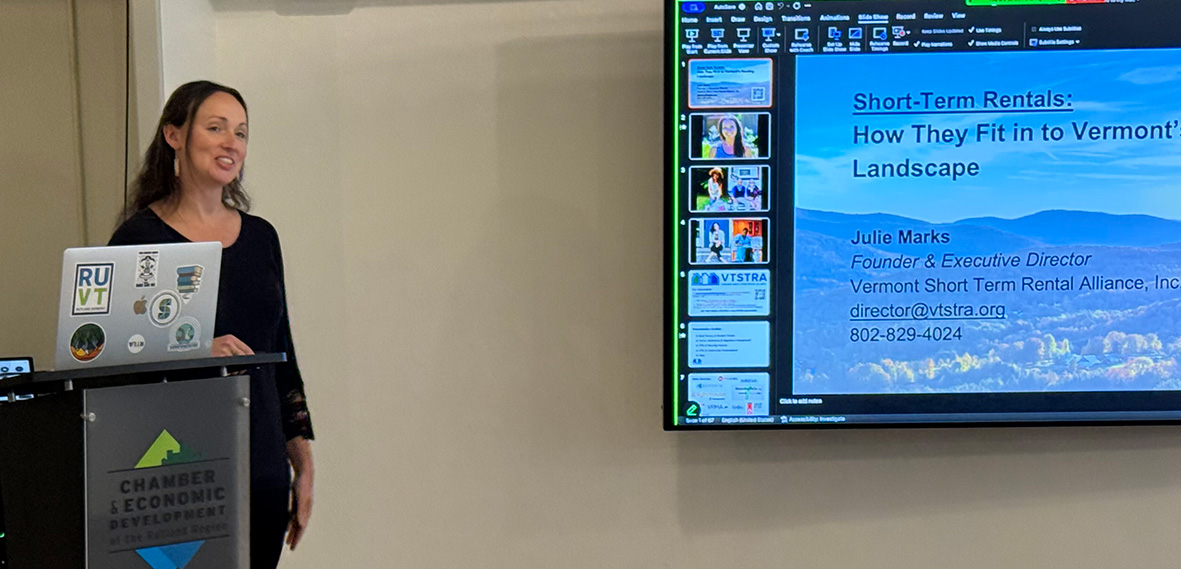By James Kent
On Friday, April 25, at a monthly Partners in Housing meeting held at the Hub CoWorks in downtown Rutland, the Vermont Short Term Rental Alliance (VTSTRA) hosted a 60-minute presentation and Q&A session for members of the public and the housing community. VTSTRA executive director Julie Marks was the afternoon’s speaker. Her goal was to educate the local community about the economic opportunities short-term rentals (STRs) offer and clear up some of the myths and concerns about an industry that seemingly has appeared out of nowhere but does have a long and rich history in Vermont.
Marks, a native Vermonter with a background in environmental health sciences, founded VTSTRA in 2021 after working closely with Burlington’s city council while developing their STR regulations. Today, the alliance has grown to over 380 members representing homeowners, property managers, and service providers across the state.
“Short-term rental hosts are everyday Vermonters—farmers supplementing their income, retirees aging in place, and entrepreneurs launching businesses,” Marks explained. “We advocate for reasonable regulations, promote responsible hosting, and work to build stronger connections between vacation rental operators and local businesses.”
STRs: An established part of Vermont’s Landscape
Although some view STRs as a new phenomenon, Marks emphasized that Vermonters have been renting out homes to visitors since the 1950s. “The vacation rental tradition is nothing new,” she said, noting its evolution from newspaper listings in the ’50s and ’60s to today’s online platforms like VRBO and Airbnb.
Today, nearly half of travelers globally prefer STRs, especially Millennials and Gen Z. Vermonters offer unique experiences that hotels often cannot: pet-friendly spaces, rural retreats, family-sized homes, and accommodations suitable for remote workers.
Marks pointed out that many STRs support medium-term stays—a growing need for traveling nurses, contractors, remote workers, and new residents. “The days of mid-term rentals being just for traveling nurses are over,” she said. “Remote workers now make up about 40% of month-to-month rentals.”
Debunking common myths
Addressing concerns that STRs are taking over Vermont’s housing stock, Marks shared data showing that the number of STRs represents only a small portion of overall housing. In Rutland and Windsor counties, STR activity remains heavily tied to seasonal tourism — not to the displacement of year-round rentals.
Moreover, according to Marks, recent studies in Vermont and other states like Maine, New Hampshire, and Canada have found little to no evidence linking STR growth to higher long-term rental rates. “We hear a lot of talk about STRs causing the housing crisis,” Marks said. “But the truth is, the factors driving the housing crisis are much broader and more complex.”
Data shows that STR activity has remained stable or increased moderately in towns like Burlington, Woodstock, and Killington even after regulations were enacted—without clear impacts on rental affordability.
Economic impact
STRs generate significant economic benefits for Vermont. In 2023 alone, STRs contributed $54 million in meals and rooms tax revenue, with an additional 3% surcharge on STR reservations added that year.
Visitors using STRs also directly support local businesses. Marks cited 2022 data showing that STR guests spent about $650 million at Vermont businesses.
“When guests stay in a short-term rental, they eat at local restaurants, shop at local stores, and use local services,” she said. “This distribution of visitor spending is critical, especially in rural areas without hotels.”
STRs also create jobs: Airbnb estimates about 6,000 Vermont jobs are indirectly supported through short-term rentals, including property management, housekeeping, maintenance, and concierge services.
A balanced approach to growth
Marks emphasized the need for thoughtful, data-driven regulation rather than reactionary bans. “We recommend starting slow, engaging with the community, and focusing on safety and registration before jumping to restrictions,” she advised.
Rather than viewing STRs and long-term rentals as mutually exclusive, Marks encouraged communities to recognize that flexible housing options—including medium-term and seasonal rentals—are part of a healthy, diverse housing market.
“Short-term rentals fill important gaps,” Marks said. “They house traveling nurses, contractors, new residents waiting for homes to be built, and visitors who support local businesses. With reasonable regulations, STRs can coexist with broader efforts to address affordable housing.”
VTSTRA continues to work with towns across Vermont to promote responsible hosting, support local economies, and maintain balance in housing markets.
“The impacts of short-term rentals are enormous — and when done right, the benefits to our communities are even greater,” Marks concluded.
For more information, visit: VTSTRA.org.



